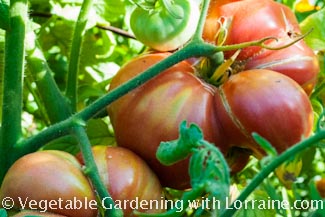- Home
- ...TOMATOES!
- Brandywine Tomatoes
Brandywine Tomatoes
A Beloved American Heirloom
History
Brandywine tomatoes have such a romantic-sounding name that even if you didn’t know how awesomely delicious they are, you would still want to grow them!
The Brandywine tomato is named after Brandywine Creek in Chester County, PA, but it's true origins remain cloaked. It appears that the "original", true-to-seed heirloom made its way from an Ohio farm family into an ad by the Johnson and Stokes Seed Company placed in “The Ohio Farmer” newspaper in 1889. But Burpee also claims that the “Turner’s Hybrid” tomato in their 1882 catalog was actually a Brandywine tomato.
Stories abound that it came from the Amish, and different farm families have grown it continuously for over 100 years. This is the wonderful nature of heirloom tomatoes: they are loved and propagated by ordinary people.
Characteristics of Brandywine Tomatoes
At any rate, the Brandywine is one of the most enduring and popular heirloom tomatoes for good reason. It is a classic, tall, winding indeterminate variety which needs plenty of support and probably yields more if pinched back to keep in “in bounds”. It has what is known as “potato leaves” (which sounds like something one tomato might say to another as an insult!), but really just means that the leaves look more like smooth-edged potato leaves than the more usual serrated-edge tomato leaf. The leaves also tend to be large: a single lower leaf on one of my Brandywines is about 8" long!
The Brandywine is considered a beefsteak variety, meaning that a single slice will cover a hamburger, and its flavor is both wonderfully sweet and tangy, like a good old-fashioned tomato should be. If you are used to round, nearly symmetrical, smooth-topped tomatoes from the store, the Brandywine's looks might shock you: they are big, uneven, gnarly and sort of dark pink rather than vivid red. I find them quite beautiful in their own way.
Cultivation
Growing Brandywine tomatoes is not much different than growing tomatoes of any other variety – they need full, all-day sun, proper staking or caging, and to be watered at ground level if possible to prevent the leaves and fruit from getting too wet. Tomatoes like consistent, deep watering without being allowed to get too dry between waterings. Inconsistent water levels can contribute to tomato leaf curl, cracking, and blossom-end rot. For more details on tomato problems caused by watering tomato plants inconsistently, check out the article on watering tomato plants.
Help share the skills and spread the joy
of organic, nutrient-dense vegetable gardening, and please...
~ Like us on Facebook ~
Thank you... and have fun in your garden!
Affiliate Disclaimer
This website contains affiliate links to a few quality products I can genuinely recommend. I am here to serve you, not to sell you, and I do not write reviews for income or recommend anything I would not use myself. If you make a purchase using an affiliate link here, I may earn a commission but this will not affect your price. My participation in these programs allows me to earn money that helps support this site. If you have comments, questions or concerns about the affiliate or advertising programs, please Contact Me.Contact Us Page




